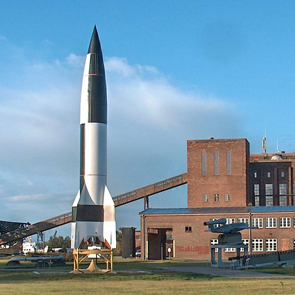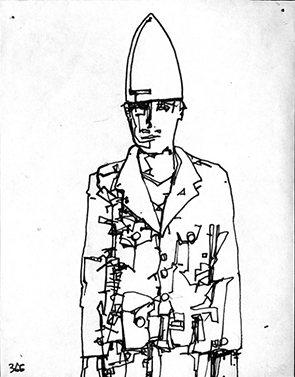This is not a guide of any sort to Thomas Pynchon’s Gravity’s Rainbow. If you are looking for a summary, a wiki for the many references in the book or some kind of concordance, there are many places to go on the internet. In fact, it is for this reason when I finished the novel a couple of days ago that I wondered what I would do with it. I formed the opinion that a single reading of this novel is not sufficient to fully appreciate it. I cannot grasp all that is in it in a single reading, and maybe not even in two. In other webpages you will be told how this is a classic postmodern work emerging from the beat generation, or that it is a meta-textual narrative about this and that. People who are writing more sophisticated appreciations of this work have read it many times and are probably familiar with all of Pynchon’s other novels, too. Prior to Gravity’s Rainbow I had only read The Crying of Lot 49. For that reason I had toyed with the idea of making a re-reading of Gravity’s Rainbow a Special Reading Project for this site; to eventually provide an in-depth analysis and tools that would help others through the book. But I hadn’t planned to do that and it would take up most of my attention for the best part of a year, I think. And I felt I couldn’t justify my time repeating what others have already done.
I was on the cusp of putting the book aside and not reviewing it at all, until I reasoned that a review could go some way to describing the novel and explaining my experience of reading it. For those with little knowledge of the book, it might give some insight – perhaps even an introduction – and for those wondering whether they want to read the book, it might help them decide.
So first, if you are looking for some support in your reading of this book, there are many many sites on the internet that can offer help, which I did not wish to replicate in a long project of my own. These are just the sites I used:
Tim Ware’s Concordance was good for looking up minor characters I’d forgotten and references I was unfamiliar with. Pynchon’s Wiki covers many of the book’s obscure references, although I sometimes found it left out what I thought needed explaining and included other things I already knew. On the whole, it was useful, although my Vintage paperback edition does not follow the pagination used by the website’s edition, the original 760 page Vintage edition (mine is 902 pages) so I had to hunt around sometimes to find what I needed, especially if I hadn’t used the site for a while. Finally, I didn’t read the Wikipedia Plot Summary until after I finished the book. The book is long, complex, with many characters, time shifts, and obscure and bizarre scenes that are sometimes not initially accessible, which makes reading a summary at the end like looking back over a difficult landscape you have just traversed.
And when looking back over the book you realise what a remarkable achievement it was for Pynchon to write it. The historical basis of the novel begins with Germany’s attacks against England towards the end of World War II with V2 rockets. If you want to read a simple novel about the V2 program, I would recommend Robert Harris’s V2. You’ll burn through it easily, but it won’t fascinate or entertain you like Gravity’s Rainbow can. Pynchon begins with those attacks and moves the narrative into some bizarre research being conducted by Britain in an attempt to counter the German technology. Psychics, séances and the like are being considered, so it is not surprising that the authorities become interested in Tyrone Slothrop, who has a strange track record: wherever he has sex, a V2 rocket lands a short while later. Naturally, the question of the connection between these events are of interest to researchers, as well as the possible aftereffects experienced by Slothrop in a research experiment he participated in while a child that involved the stimulation of his penis. A warning: this is a mild example of a facet of the novel. If reading about sex, especially of the more bizarre kind, bothers you, Gravity’s Rainbow may not be for you. There are scenes of group sex, domination, S & M, eating shit as part of a sexual act, paedophilia, castration and more. This is not a vanilla book. It’s sexual scenes are extreme, but everything about the book is extreme, including its wild narrative shifts, the plethora of characters (some with multiple names), as well as screamingly funny scenes which I think are worthy of writers like Pratchett or Tom Sharpe or Wodehouse, although the situations in which they occur are not the prurient scenarios or mannered domestic set pieces we are familiar with in British writing, but closer to the despairing rage of something like Catch-22, without so much rage and despair, in which the ridiculous and outrageous is turned up to eleven. One sequence involves an attack on a German V2 base with a troupe of dancing girls and escaped chimpanzees. Unless you read it, it’s really hard to imagine how that happens.
Slothrop is drafted into the PISCES group (‘Psychological Intelligence Schemes for Expediting Surrender’) which focuses on psychological and psychic warfare, after Teddy Bloat photographs Slothrop’s map of his sexual conquests around London. Roger Mexico, a statistician in PISCES, identifies the correlation between Slothrop’s sexual activity and the distribution of rocket strikes within the city. Slothrop undergoes tests to determine what is happening, and various theories are put forward concerning his strange prescience, including Edward Pointsman’s theories based on Pavlovian conditioning and other more bizarre ideas suited to the fringe work being done in PISCES. But Slothrop’s story, while it is the main story that ties everything together, is not the only story. There are hundreds of characters in the book, some only appearing once, some appearing in the first part of the book and not returning until the fourth and last part. Captain Blicero, for instance, a sadistic SS officer who keeps Katje and Gottfried as sex slaves, works on the V2 rocket and its launches. He appears in a flashback sequence in the first part of the book. Katje will later be revealed to have another identity, as will Blicero, himself. Then there is Franz Pökler, a German chemical engineer, who is given a long personal story in the third part of the novel, in which Blicero manipulates him to work on the development of the V2 rocket. Pökler has been separated from his wife, Leni, and Blicero uses access to Pökler’s daughter, Ilse, as a means of controlling Pökler. This narrative concerning Blicero and his sexual and psychological manipulation of others is anticipated in the flashback early on. But Blicero’s story is weaved throughout the novel.
Once Slothrop leaves the confines of PISCES the story becomes more expansive. He is first sent to the Casino Hermann Goerring in newly liberated France where his research reveals the manufacture of a rocket with a peculiar serial number – 00000 – fitted with a new component called the Schwarzgerat, made from a black plastic called Impolex G, by a scientist, Laszlo Jamf, whom we later learn has a connection to Slothrop’s family. Other more bizarre moments include a scene in which Slothrop rescues Katje from a trained giant octopus prior to starting a sexual relationship with her. But if Pynchon’s story is somewhat unconventional, it is easy enough to follow well into the third part. The narrative begins to fragment more once Slothrop sets out to look for the Schwarzgerat by himself – a somewhat picaresque journey – in which he follows clues or is side tracked, is threatened and chased, speaks to and sleeps with different people, and assumes a variety of disguises.
What makes Gravity’s Rainbow a more challenging read? There are a few aspects of Pynchon’s style and structure which are deliberately challenging. Sometimes it is simple things, like the way Pynchon uses lists. Until you are aware of it, novelists often get away with using lists to describe scenes. A list can be obvious, like the following from Fitzgerald’s Tender is the Night:
She bought coloured beads, folding beach cushions, artificial flowers, honey, a guest bed, bags, scarfs, love birds, miniatures for a doll’s house, and three yards of some new cloth the colour of prawns.
A little further on in the same passage, we are told:
Nicole was the product of much ingenuity and toil. For her sake trains began their run at Chicago and traversed the round belly of the continent to California; chicle factories fumed and link belts grew link by link in factories; men mixed toothpaste in vats and drew mouthwash out of copper hogsheads; girls canned tomatoes quickly in August or worked rudely at the Five-and-Tens on Christmas eve; half-breed Indians toiled on Brazilian coffee plantations and dreamers were muscled out of patent rights in new tractors - these were some of the people who gave a tithe to Nicole . . .
Fitzgerald’s use of lists in this passage first introduces the reader to the purchases of Nicole’s shopping trip, which means the language is focused around nouns. The second list is structured around verbs – ‘canned’, ‘toiled’ etc – suggesting the privilege by which Nicole, an heiress living her life by the work of others, has bought these items. Lists are a good way of creating a scene or giving information.
Pynchon uses lists similarly, but the experience of reading them is different. When reading Pynchon it’s useful to know when a list is beginning in the narrative because it’s easy to be lost in the multiplying details before you wonder where the story has gone. Descriptive lists can continue for a page or two, sometimes with bizarre and distracting details which may or may not be significant, thereby dividing your attention between where you thought the narrative was going and possible tangents, which do happen. If you’ve mentally marked where the list begins and you make it through its descriptive detail to the end and discover the narrative continues as you expect, you can smile and continue.
But consider the potential revealed in the cumulative detail within the narrative pyrotechnics of this simple scene. Lyle Bland, Slothrop’s uncle, is playing a pinball machine:
The second ball isn’t even out of the chute before Bland gets another TILT, again without having applied any English. Third ball gets stuck somehow against a solenoid and (helphelp, it’s hollering, wounded high little voice, oh I’m being electrocuted…) dingdingding, gongs and racing numbers up on the board, 400,000, 675,000 bong a million! greatest Folies-Bergères score in history and climbing, the poor spherical soul against the solenoid trashing, clonic, horrible (yes they’re sentient all right, beings from the planetoid Kat spiel, of veryvery elliptical orbit—which is to say it passed by Earth only once, a long time ago, nearly back at the grainy crepuscular Edge, and nobody knows where Katspiel is now or when, or if, it’ll be back. It’s that familiar division between return and one-shot visitation. If Katspiel had enough energy to leave the sun’s field forever, then it has left these kind round beings in eternal exile, with no chance of ever being gathered back home, doomed to masquerade as ball bearings, as steelies in a thousand marble games—to know the great thumbs of Keokuk and Puyallup, Oyster Bay, Inglewood—Danny D’Allesandro and Elmer Ferguson, Peewee Brennan and Flash Womack … where are they now? where do you think? they all got drafted, some are dead on Iwo, some gangrenous in the snow in the forest of Arden, and their thumbs, first rifle inspection in Basic, GI’d, driven deep back into childhood as little finger sweat-cams off M-1 operating handle, thumb pushing down follower still deep in breech, bolt sshhOCK! whacks thumb oh shit yes it hurts and good-by to another unbeatable and legendary thumb, gone for good back to the summer dust, bags of chuckling glass, bigfooted basset hounds, smell of steel playground slides heating in the sun), well here come these cancan girls now, Folies-Bergères maenads, moving in for the kill, big lipstick smiles around blazing choppers, some Offenbach gallop come jigging in now out of the loudspeakers that are implicit in this machine’s design, long gartered legs kicking out over the agony of this sad spherical permanent AWOL, all his companions in the chute vibrating their concern and love, feeling his pain but helpless, inert without the spring, the hustler’s hand, the drunk’s masculinity problems, the vacuum hours of a gray cap and an empty lunchbox, needing these to run their own patterns down the towering coils, the deep holes with their promises of rest that only kick you wobbling out again, always at the mercy of gravity, finding now and then the infinitesimally shallow grooves of other runs, great runs (twelve heroic minutes in Virginia Beach, Fourth of July, 1927, a drunken sailor whose ship went down at Leyte Gulf…flipped up off the board, your first three-dimensional trip is always your best, when you came down again it wasn’t the same, and every time you’d pass anywhere near the micro-dimple you made when you feel, you’d get a rush . . . sobered, a few, having looked into the heart of the solenoid, seen the magnetic serpent and energy in its nakedness, long enough to be changed, to bring back from the writhing lines of force down in that pit an intimacy with power, with glazed badlands of soul, that set them apart forever—check out the portrait of Michael Faraday in the Tate Gallery in London, Tantivy Mucker-Maffick did once, to fill up a womanless and dreary afternoon, and wondered then how eyes of men could grow so lambent, sinister, so educated among the halls of dread and the invisible…) but now the voices of the murder-witness coquettes grow shrill, with more of a blade’s edge, the music changes key, pitching higher and higher, the ruffled buttocks bumping backward more violently, the skirts flipping redder and deeper each time, covering more of the field, eddying to blood, to furnace finale, and how’s the Katspiel Kid gonna get out of this one?
I’ve colour coded different lists in the passage to help understand how it’s structured and what each list is doing. On first reading the paragraph it seems overwhelming, but it’s a great example of Pynchon’s style. A first impression is that it is overburdened by details that cumulate not just detail or action, but is an impressionistic stream of conscious narrative. Here we have the use of lists as well as a typical Pynchon digression which appears to have little to do with the story, yet on consideration we find the passage echoes thematic elements in other parts of the novel. Uncle Lyle inveigles his way into the Masons when he has a bunch of faulty pinball machines fixed. Through the teachings of the Masons he learns to leave his body and astral travel. Eventually he is able to transcend the physical plane altogether. This scene accentuates Lyle Bland’s mystic progression in through the physical entrapment of the ball bearing in the solenoid of the pinball machine. Through a brilliant conceit, the ball bearing becomes, in Pynchon’s hands, a part of the race from a small planet called Katspiel that have been entrapped on Earth, now literally being tortured in the bowels of the machine, but who share a tragic fate with the men who once played the machines, sent off to war. Imbedded in this short narrative are other associations within the novel: of the V2 itself, governed also by the forces of gravity as it reaches Brennschluss, the top of the arc of its parabolic trajectory, at which point gravity will determine its final movement, much like the moment when the steelie is first flipped off the pinball surface; or Blicero’s conflation of violence and sexuality in his desire to entrap Gottfried in the heart of the V2 as it launches, much the same as the Katsiel kid is trapped within the pinball machine; or several transcendent moments in the novel when we are perceive a world beyond physical limitations. But also the psycho-sexual peccadilloes of men like Blicero and Pudding (who willingly eats his own shit), enslaved to their desires, are suggested in the shrill entrance of the dancers onto the stage at Folies-Bergères. As often with Pynchon, the sense of reading is of a large bowl of octopi being dumped on the floor in front of you in a squirming mess. But we find a close, slow reading is rewarding.
Another aspect of Pynchon’s writing is that he tends to introduce new elements to the story without explanation or context. A minor example is the Katspiel steelie in the pinball machine. Yet this does not necessarily happen as you read lists, but may be introduced at any time, leaving you to wonder who these new characters are and how this entirely new scenario relates to other aspects of the book you have already read. In the first few pages of the novel, for instance, we are confronted with Lord Blatherard Osmo’s adenoid problem, which suddenly becomes a raging threat on the scale of the Blob. His adenoid, “at least as big as St.Paul’s”, rampages through London with a master plan to take over. It’s one of many amusing set-pieces in the book but initially it is somewhat disorientating as the story is only starting to take shape. After that, the adenoid only gets mentioned somewhere in the closing pages of the book. As your reading progresses you develop a familiar sense that Pynchon’s scenes alternate between disorientating, unexplained sequences without initial context, and other that move along as most novels do at an entertaining trot. Pynchon’s normal practice is to introduce new material without explanation and allow his reader to discover how it is relevant to the wider story, and as that movement takes place, the novel tends to return to more accessible territory again. The introduction of Enzian, for example, and the Herero massacre of 1904, seems an entirely tangential move. But Slothrop later meets the Schwarzkommandos, a fictional group of African rocket technicians descended from the Hereros, and we also discover that Tchetcherine, a Soviet intelligence officer, is Enzian’s half-brother and tasked with destroying the Shwarzkommandos, who also seek the Schwarzgerat, as they find mystical significance in it construction.
So, despite Pynchon’s style, Gravity’s Rainbow is not a particularly difficult book over the first half as long as you read attentively. Eventually, Slothrop is convinced he must leave the Casino Hermann Goerring and seek out the Schwarzgerat, himself, to solve the mystery of Impolex G, which might help him understand his link to the rocket, as well as get him out of PISCES. It is during the third part of the novel, as he travels about Europe engaging in one incident after another – anything from having sex with a former porn star who turns out to be someone we have already met in the plot, to attempting to retrieve an enormous amount of hashish from the very house in which the American delegation is staying during the Potsdam Conference – that a reader may begin to feel more disoriented within the narrative. In part, this reflects Slothrop’s own disintegrating mental state. Slothrop is increasingly paranoid, that ‘the Man’ and ‘They’ control everything. By the fourth part of the novel Slothrop’s mental state is in decline. Tales of kamikaze heroes and even the long tale of a sentient light bulb called Byron (‘Byronic’?) who desires to lead his fellow light bulbs in a resistance against humans, are difficult to explain with any exactness, at least on a first reading, but it seems clear that Slothrop’s paranoia is debilitating and these scenes reflect something of that.
The fact is, there are simply too many elements in the story to write about in a review, and this is also part of the difficulty that is credited to the book. The sometimes chaotic nature of the narrative is partly owed to the multitude of scenes, characters and allusions which can be overwhelming. Slothrop is a main character in a traditional sense, but Pynchon’s narrative does not privilege his position because it eschews traditional narrative cohesion. Instead, it becomes a dialectic construct in which multiple threads are given co-equal weight and no theory or point of view has authority. Slothrop’s uncanny sexual correlation with the bomb strikes is explained variously as a statistical anomaly, as precognition and even psychokinesis by the scientists of PISCES, but we are also aware of the association of sex with the bomb by Blicero, and the bizarre sexual union he hopes to achieve by sending up a manned version of the V2. We are also aware of the political and scientific significance of the V2 as the Americans try to remove technology from Mittelwerk after the war before the Russians can obtain it, and the mystical significance placed upon the bomb by some of the Herero. Even Slothrop’s identity is not fixed. He infiltrates Mittelwerk in the guise of an English war reporter, adopts the identity of Rocketman (wearing a Viking helmet with the horns removed to resemble the top of a rocket), and even travels about in a pig costume late in the book after serving as Plechazunga, a mythic hero pig who thwarted a Viking invasion, in an annual town parade in Cuxhaven. By the fourth section of the book there is a feeling that Slothrop’s sense of self is tenuous and he may even have displaced his fantasies into the lightbulb, Byron. The ranging nature of the narrative, Slothrop’s paranoia, and a sense that meaning – a trite explanation of what this is all about – is deferred, results in a perception of numinous significance, which is imbued by Pynchon in ordinary objects, like the steelie in the pinball machine, or Ronald Cherrycoke’s perception of an existence beyond understanding – an ‘Outer Radiance’ later witnessed by Slothrop – of “robed figures … hundreds of miles tall” in the shape of angels in the sky: that, indeed, there is so much connected in the world that we try to make sense of, but true significance, is just beyond our perception and may only be intuited.
Anyone who has read Gravity’s Rainbow will know how little I have said about the book. As I stated to begin with, the only thing I can do in a review of this length is to give an impression of what the book is about and what it might be like to read it. Before I finish I want to reiterate just how funny some moments in this book are. Some of the scenes are truly ridiculous, like an air chase between a hot air balloon Slothrop rides in and a plane commanded by Major Marvy. Incensed at being thrown from a train in a previous scene and Slothrop’s presence in Mittelwerk, Marvy pursues Slothrop and receives the additional – and quite improbable – indignity, of a custard pie in the face, thrown from the balloon by Slothrop as Marvy rages from the open door of the plane in the middle of the sky. Pynchon’s novel also has a bunch of funny poems and songs, the Mittelwerk sequence is littered with rude limericks, and the narrative, itself, is dotted with groan-worthy puns, like the one about devotees of the I Ching who can never stay in one place for very long because “they always have I Ching feet!” That’s the thing about the novel. It’s playful and you have to actively engage with it. It’s not meant to be read quickly. I’m sure it will be satisfying when I eventually get back to reading it a second time. It’s a book to be savoured. That makes it a little difficult, but ultimately it makes it extremely rewarding.
Also by Thomas Pynchon:

 RSS Feed
RSS Feed Facebook
Facebook Instagram
Instagram YouTube
YouTube Subscribe to our Newsletter
Subscribe to our Newsletter











No one has commented yet. Be the first!